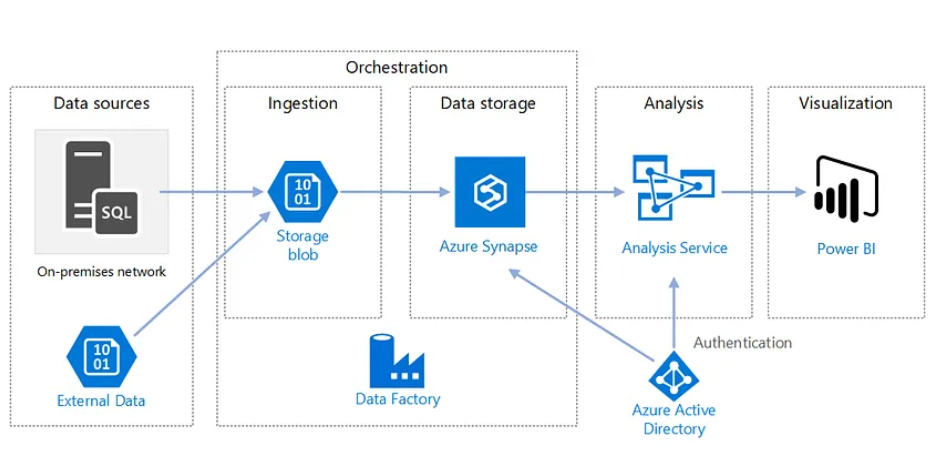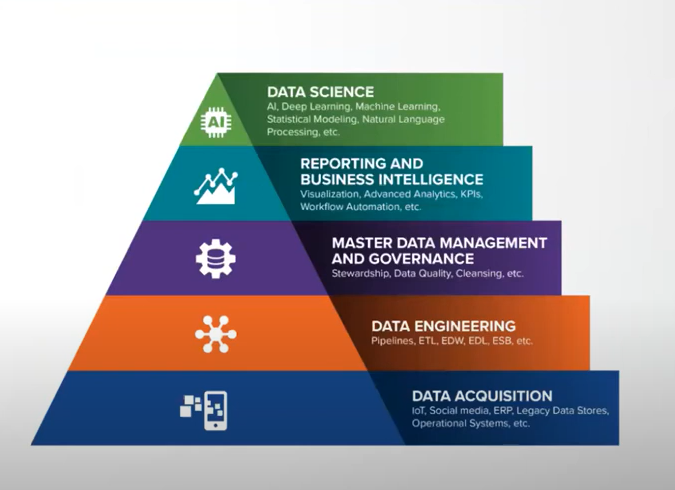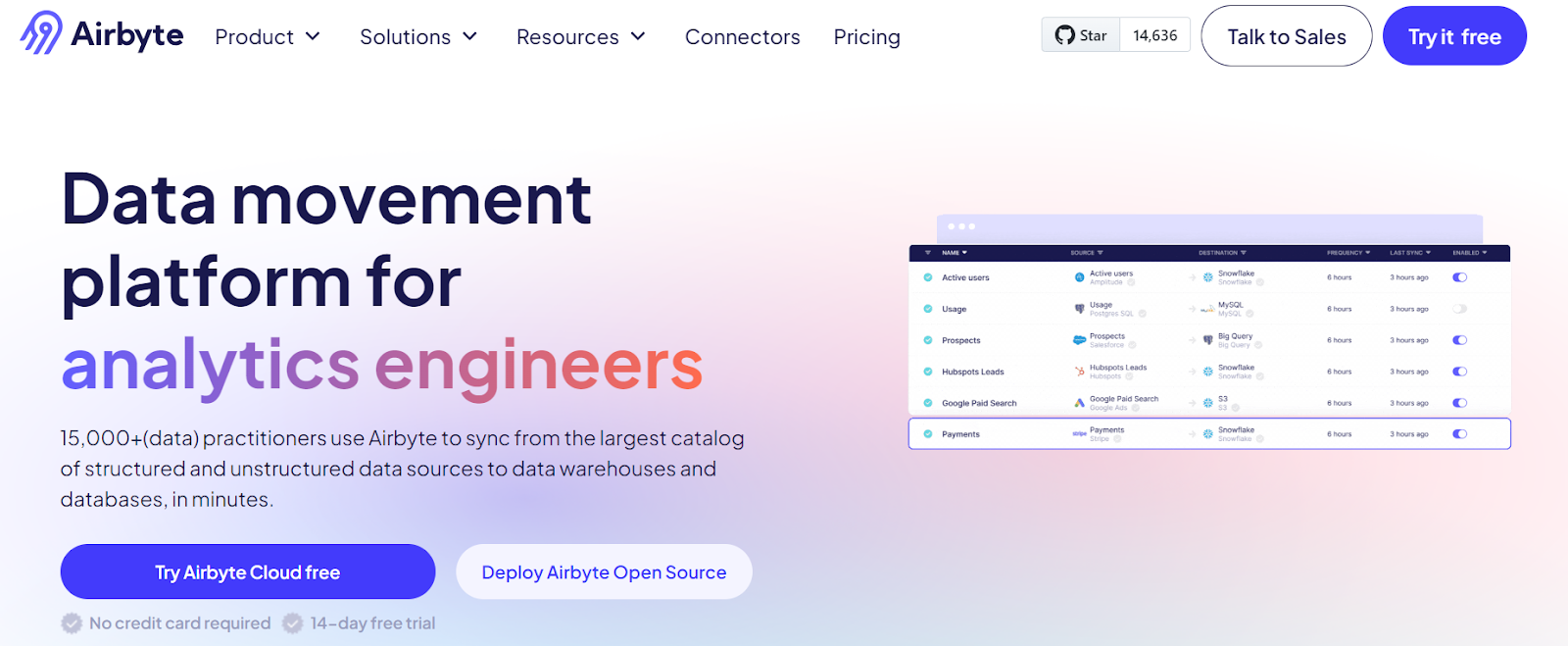What is Modern Data Warehouse: Architecture & Design
Summarize this article with:
✨ AI Generated Summary
Modern data warehouses are cloud-based, scalable systems designed to store and process large volumes of structured, semi-structured, and unstructured data from diverse sources, enabling advanced analytics, AI, and machine learning. They offer benefits such as cost-effectiveness, faster data processing, enhanced security, and seamless integration with BI tools for interactive reporting.
- Support ELT/ETL data integration and flexible data management with strong governance.
- Enable scalable, pay-as-you-go infrastructure without the need for on-premise maintenance.
- Facilitate migration through clear objectives, source identification, platform selection, and data integration tools like Airbyte.
Data warehouses play an important role in data analysis and business intelligence. Since their inception, they have evolved and become versatile services that support AI and machine learning applications for advanced data analytics.
Modern data warehouses have features like enhanced scalability, flexibility, analytics capabilities, and cost-effectiveness. You can use them to transform raw data into meaningful insights and gain a competitive advantage in your industry.
This article explains the modern data warehouse concept in detail, along with its benefits and purpose to help you make your business more scalable and profitable.
What is a Modern Data Warehouse?
A modern data warehouse is a data management system that acts as a single repository to store, transform, and handle massive amounts of data from various sources. It is a cloud-based solution that offers flexibility to store different data types, such as structured, semi-structured, and unstructured data from multiple sources. You can think of it as an evolved version of a traditional data warehouse for advanced analytics.
Modern data warehouses are highly scalable and enable efficient handling of large volumes of data, reducing expenses on additional storage systems. You can use them with AI and machine learning-based applications to perform complex queries and unlock deeper insights. They also integrate well with BI solutions, allowing you to create interactive reports to achieve a comprehensive understanding of your data.
Purpose of Modern Data Warehouses

Take a look at some important purposes of a modern data warehouse:
- Data Integration and Consolidation: You can seamlessly integrate and consolidate data from various sources in a modern data warehouse. It acts as a centralized repository for storing any data format. This unified view empowers further processing and analysis to gain useful insights for your business.
- Data Storage and Management: Modern data warehouses are designed to store massive amounts of data. They also support data transformation and cleaning to remove any inconsistencies in the datasets. You can leverage these capabilities to improve data quality and accessibility.
- Advanced Analytics: These warehouses facilitate advanced analytics through AI, machine learning, and various statistical models. This helps identify patterns, predict future trends, and better understand business domains.
- Data Reporting: You can integrate modern data warehouses with various visualization tools to obtain interactive reports and dashboards on your data. These visualizations allow you to track multiple metrics and make better organizational decisions.
Modern Data Warehouse Pyramid
The modern data warehouse pyramid represents the key stages involved in data warehousing. Here’s a breakdown of each level:

Level 1: Data Acquisition
The first level of the modern data warehouse pyramid involves collecting data from various sources. These sources can include traditional databases, log files, IoT devices, websites, or social media content. Data can be ingested from these sources in batches or in real-time, depending on the business's needs.
Level 2: Data Engineering
After data collection, the next step is to upload it to your modern data warehouse in a suitable format. To get this done, you need to prepare your data in a format that is compatible with the destination system. This might involve data transformation or data pipeline building to ensure the data is structured and ready for analysis.
Level 3: Data Management Governance
The next level of the modern data warehouse pyramid is data management governance. This step ensures the quality, security, and effective governance of your data. For this, you should clearly define your objectives and policies of the data governance framework.
You can also leverage tools for data cataloging, policy enforcement, and metadata management to streamline data quality. Moreover, you should establish an effective data stewardship role to secure and protect your data.
Level 4: Reporting and Business Intelligence
Once the data is organized and cleaned, this level focuses on using BI solutions like Power BI or Tableau to create visual reports and dashboards. The role of data warehouses in the BI is to uncover patterns and trends and provide valuable insights for decision-making.
Level 5: Data Science
After analysis, you can apply different data science techniques to gain an in-depth knowledge of your data. This includes deploying machine learning and statistical models to perform complex queries on your datasets. You can also use AI-based applications to make data-driven decisions.
Modern Data Warehouse vs Traditional Data Warehouse
The comparative analysis of modern and traditional data warehouses is as follows:
Purpose
Modern data warehouses are designed to process a high volume of data of any format. Conversely, traditional data warehouses are designed to process data of specific workloads and data types.
Location
Modern data warehouses are cloud-based; you do not have to manage their infrastructure. Contrary to this, traditional data warehouses are usually deployed on-site, and you must manage infrastructural requirements.
Data Sources
Modern data warehouses can accept data from diverse sources, such as traditional databases, websites, social media, or IoT applications.
In contrast, traditional data warehouses can only accept data from conventional sources, such as operational or transactional databases.
Data Integration
You can implement the ELT (Extract, Load, Transform) or ETL (Extract, Transform, Load) approach while using modern cloud-based data warehouses. Traditional data warehouses, on the other hand, mostly support the ETL approach, in which data is transformed and cleansed before being loaded into the warehouse.
Know the key differences between ETL and ELT with this comprehensive guide.
Scalability
Modern data warehouses have high scalability, and you can scale it horizontally or vertically to accommodate evolving data needs. Contrary to this, scaling traditional data warehouses beyond their set limits can be complex and expensive.
Costs
The modern data warehouse is cost-effective due to lower operational and maintenance costs. Several modern data warehouse services offer a pay-as-you-go pricing model that allows you to spend only on the services you use to process your data.
Traditional data warehouses are expensive compared to modern data warehouses because you have to invest significantly in the infrastructure's operation and maintenance.
A tabular comparison of various characteristics of modern and traditional warehouses is as follows:
Benefits of a Modern Data Warehouse
Some of the benefits of the modern data warehouse are as follows:
Less Maintenance
Being a cloud-based, modern data warehouse eliminates the need for infrastructure management. As a result, this translates to cost savings, reduced time, and minimized risk of errors and security breaches.
Faster Speed
Utilizing a modern data warehouse can speed up data processing, as it offers better processing resources and higher computing power than traditional options. It enables the ELT approach, where you can directly load and then transform the data in the warehouse.
This simplifies the data pipeline and reduces processing time. Additionally, the ELT approach also allows you to easily access raw data within the data warehouse for initial processing and data quality checks.
More Flexibility
Modern data warehouses facilitate the storage of structured, semi-structured, and unstructured data. You can seamlessly integrate data from various sources into the modern data warehouse using third-party tools. Furthermore, it offers in-built advanced analytics and machine learning capabilities, empowering you to perform complex data analysis and gain a competitive edge.
Easier to scale
Modern data warehouses offer easy scaling up or down according to your workload. This enables you to process large volumes of data without incurring additional costs.
Most data warehouses facilitate the independent scaling of compute and storage resources, optimizing query performance. Additionally, they also provide hybrid or multi-cloud support that allows you to leverage on-premise and other cloud resources for further cost optimization.
Enhanced Data Security
A modern data warehouse efficiently secures your data through its robust security features. It supports encryption at rest and in transit, role-based access control, and user authorization that enables you to protect business-critical data from cyber threats.
Lower Upfront Costs
In modern data warehouses, the cloud service provider handles infrastructure management. You only have to pay for its storage and CPU time usage. This pay-as-you-go pricing model makes modern data warehouses a cost-effective solution.
Steps for Migrating to a Modern Data Warehouse
You can follow these steps to migrate data to a modern data warehouse efficiently:
Understand Your Business Requirements and Set Clear Objectives
You should clearly know the objectives you want to achieve by migrating data to a modern data warehouse. This may include goals such as improved performance, scalability, cost-cutting, or conducting advanced analytics.
You should also identify and resolve the needs and challenges of all the stakeholders who will engage in the data migration process. In addition, you can conduct a budget analysis to understand the expenses involved in the migration.
Identify Your Data Sources and Processes
For seamless data migration, you should first identify all relevant data sources from which you want to gather your data. This data can be loaded to the warehouse in different ways, such as full or incremental loading. You can also prefer to transfer data through real-time or batch data ingestion.
Deciding these processes in advance provides a clear roadmap for your data migration. You should also decide beforehand the practices you will adopt for analytics, business intelligence, data governance, and security.
Select the Right Data Warehouse
Several data warehousing services exist, such as Amazon Redshift, Google BigQuery, Microsoft Azure, and Oracle. You should select the right data warehouse for migration depending on your objectives and resources. Before migration, you can compare each service's scalability, performance, cost, security, and integration capabilities here.
Use Data Integration Tools
Modern data warehouses are efficient solutions for storing data from various sources, but to truly leverage its potential, you need to ensure your data is integrated and standardized. This is where data integration can assist you in consolidating scattered data into a consistent format.

Airbyte is one such powerful data integration tool that enables you to gather data from numerous sources and unify it in your desired destination warehouse. To simplify this process, it offers an extensive library of 350+ pre-built connectors. You can also build your own connectors if they are not available in the existing set of connectors using the Airbyte’s CDK.
Some of the prominent features of Airbyte are as follows:
- Streamlined Data Ingestion: Airbyte facilitates seamless data ingestion from any source to your desired data warehouse with an easy-to-use interface and a large library of connectors. This simplifies data movement and minimizes discrepancies in building data pipelines.
- Change Data Capture: Airbyte's CDC feature allows you to track the changes made at the data source. You can then replicate these changes in your destination data warehouse to keep it in sync with the source.
- PyAirbyte: PyAirbyte is an open-source Python library offered by Airbyte. You can use it to retrieve data from multiple sources using Airbyte-supported connectors within your Python environment.
Improvise
Your objectives for data migration, along with storage solutions and sources, may change over time according to your business requirements. You should continuously improve your migration strategy to align with these changes.
You can seek feedback on this from your senior authorities or domain experts. It is also advisable to update and maintain documentation of the migration process for future reference.
Conclusion
Modern data warehouses are an integral part of data management today. They are a cost-effective solution for storing and processing enormous datasets on a large scale. This blog provides holistic information on modern data warehouses. It also explains the purpose and benefits of data warehouse modernization. You can use the data migration steps given in this blog to migrate your data to any modern data warehouse.
FAQs
1. What is the modern architecture of a data warehouse?
The modern architecture of a data warehouse is mostly distributed, flexible, and cloud-based, with options for hybrid models. Modern data warehouses leverage cloud storage, MPP for parallel processing, and in-memory computing for speed.
2. What is the latest trend in data warehouses?
The latest trends in data warehouses include AI-driven automation for data management, zero-trust security, in-memory computation for faster analytics, in-database processing to reduce latency, and adoption of DataOps practices alongside cloud-native, lakehouse, and hybrid architectures.
3. What will replace data warehouses?
Data lakehouses are likely to replace traditional data warehouses, offering a unified solution that combines the flexibility of data lakes with the structure and performance of warehouses. Modern warehouses like Snowflake are also evolving to incorporate lakehouse features.
4. Is Microsoft Azure a data warehouse?
No, Microsoft Azure is a cloud computing platform that offers several data-related services, such as storage, processing, analytics tools, etc.
5. How to build a modern data warehouse?
You can follow the steps given here to build a modern data warehouse:
- Define the goals you want to achieve by building a data warehouse.
- Select a data warehouse platform as per your requirements and design its schema.
- Integrate data from different sources into the data warehouse using a suitable data integration tool.
- Test the data warehouse by checking the accuracy, relationships between data, and the alignment of the data warehouse schema with your business requirements.
- Deploy security measures such as encryption, user authentication, and role-based access control.

.png)